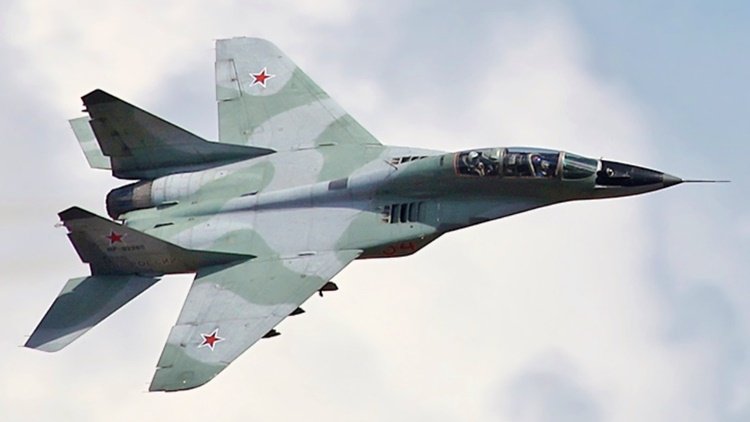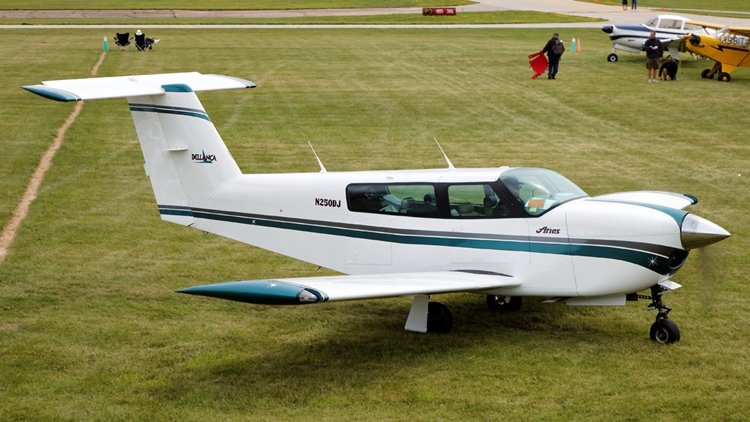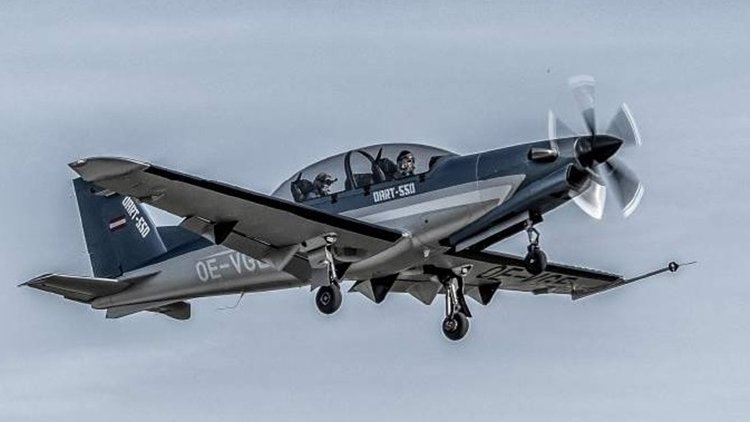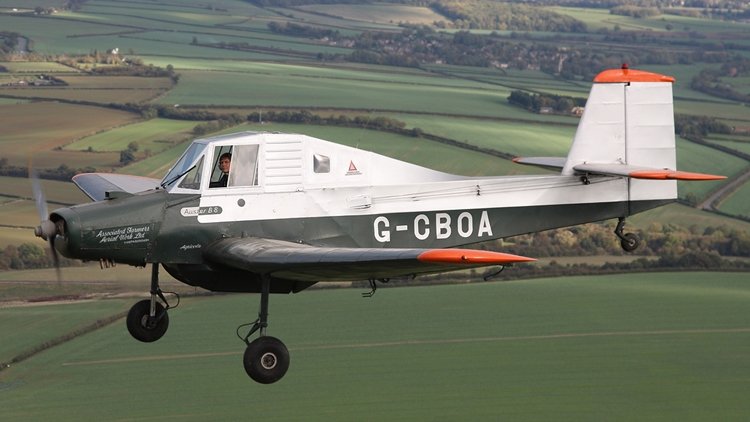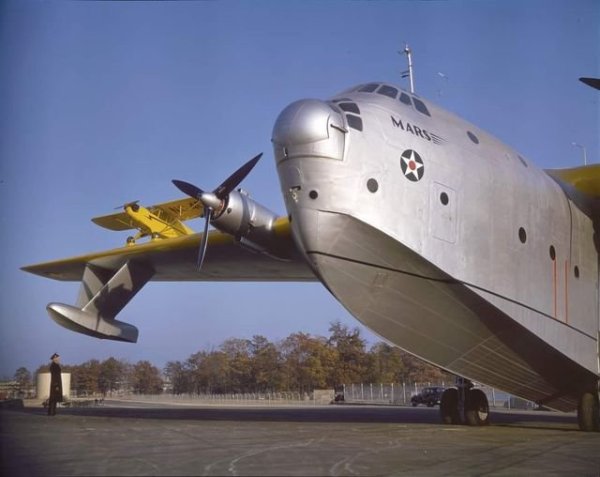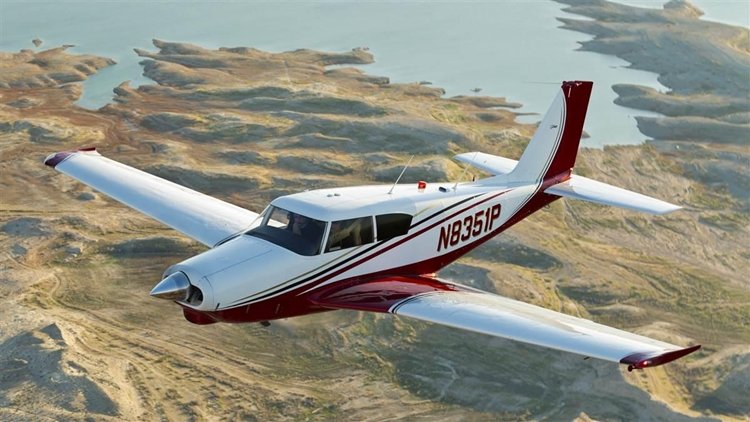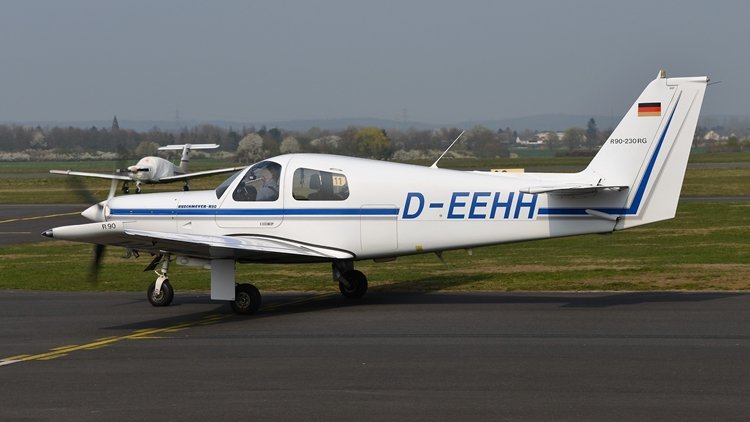-
Posts
7,576 -
Joined
-
Last visited
-
Days Won
67
Content Type
Profiles
Forums
Gallery
Downloads
Blogs
Events
Store
Aircraft
Resources
Tutorials
Articles
Classifieds
Movies
Books
Community Map
Quizzes
Videos Directory
Everything posted by red750
-
The Cierva W.11 Air Horse was a helicopter developed by the Cierva Autogiro Company in the United Kingdom during the mid-1940s. The largest helicopter in the world at the time of its debut, the Air Horse was unusual for using three rotors mounted on outriggers, and driven by a single engine mounted inside the fuselage. Only two aircraft were built, further development by Cierva was stopped after the crash of the first one and little work was done under Saunders Roe before the project was ended and the second aircraft was scrapped in 1951.
-
The object above the cockpit in the last photo above is a mirror for the pericope used by the instructor in the trainer variant, to see the runway over the head of the trainee in the front cockpit.
-
The Mikoyan MiG-29 (Russian: Микоян МиГ-29; NATO reporting name: Fulcrum) is a twin-engine fighter aircraft designed in the Soviet Union. Developed by the Mikoyan design bureau as an air superiority fighter during the 1970s, the MiG-29, along with the larger Sukhoi Su-27, was developed to counter new U.S. fighters such as the McDonnell Douglas F-15 Eagle and the General Dynamics F-16 Fighting Falcon. The MiG-29 entered service with the Soviet Air Forces in 1983. While originally oriented towards combat against any enemy aircraft, many MiG-29s have been furnished as multirole fighters capable of performing a number of different operations, and are commonly outfitted to use a range of air-to-surface armaments and precision munitions. The MiG-29 has been manufactured in several major variants, including the multirole Mikoyan MiG-29M and the navalised Mikoyan MiG-29K; the most advanced member of the family to date is the Mikoyan MiG-35. Later models frequently feature improved engines, glass cockpits with HOTAS-compatible flight controls, modern radar and infrared search and track (IRST) sensors, and considerably increased fuel capacity; some aircraft have also been equipped for aerial refueling. Following the dissolution of the Soviet Union, the militaries of multiple ex-Soviet republics have continued to operate the MiG-29, the largest of them being the Russian Aerospace Forces. The Russian Aerospace Forces wanted to upgrade its existing fleet to the modernised MiG-29SMT configuration, but financial difficulties have limited deliveries. The MiG-29 has also been a popular export aircraft; more than 30 nations either operate or have operated the aircraft. As of 2024 Flight Global estimates that 809 MiG-29s, of all types, are in service with air forces, making it the 5th most common active fighter. Sharing its origins in the original PFI requirements issued by TsAGI, the MiG-29 has broad aerodynamic similarities to the Sukhoi Su-27, but with some notable differences. The MiG-29 has a mid-mounted swept wing with blended leading-edge root extensions (LERXs) swept at around 40°; there are swept tailplanes and two vertical fins, mounted on booms outboard of the engines. Automatic slats are mounted on the leading edges of the wings; they are four-segment on early models and five-segment on some later variants. On the trailing edge, there are maneuvering flaps and wingtip ailerons. The MiG-29 has hydraulic controls and a SAU-451 three-axis autopilot but, unlike the Su-27, no fly-by-wire control system. Nonetheless, it is very agile, with excellent instantaneous and sustained turn performance, high-alpha capability, and a general resistance to spins. The airframe consists primarily of aluminum with some composite materials, and is stressed for up to 9 g (88 m/s²) maneuvers. The controls have "soft" limiters to prevent the pilot from exceeding g and alpha limits, but the limiters can be disabled manually. For much more detail on development, design, operational history and variants, click here.
-
The Bellanca T-250 Aries was a light airplane built in the United States in the early 1970s, which achieved only limited production. Designed by Marvin Greenwood in Texas while his company, Anderson-Greenwood, owned the Bellanca name, it was offered as a Bellanca product. It was a conventional low-wing monoplane with retractable tricycle undercarriage and a high T-tail. Federal Aviation Administration type certification was obtained on 28 July 1976. Number built 5
-
Pitcairn PA-36 Developed in 1938, the PA-36 has an all metal fuselage and rear engine. The front wheels are steerable. Tabular details here,
-
The RUMAS 10 is a strikingly designed light helicopter by the Czech-based RUMAS (Russian Ukraine Maslova) group. The helicopter uses a three-bladed coaxial counter-rotating main rotor system along with a pusher-type tail rotor reminiscent of the Sikorsky S-97 Raider. The 10 is intended primarily for civil use and takes the unmanned future of aviation into account with its design. Unlike most helicopter the 10 has a main rotor that is not tilted during flight, since propulsion is provided by the rear pusher-type propeller. This is a feature that significantly decreases drag. The rear propeller is a high-speed fully reversible unit that can quickly change its thrust vector to accelerate or brake the aircraft. The combination of these different design features results in a helicopter with a guaranteed cruise speed of 155 mph (250 kph) and a designed top speed of 186 mph (300 kph). This is a 75% improvement on the cruising speed of traditional light helicopters. A higher flight speed translates to lower per-hour flight costs, coupled with an asking price estimated at 850 000 USD the 10 becomes a very attractive prospect, as it is in the same price range as a Bell 206 Jet Ranger. An aircraft that tops out at 137 mph (222 kph). Another interesting aspect of the 10 is the choice of power plant. One may have either a single gas turbine engine rated at 220 horsepower or two rotary piston engines for a similar combined rating. The relatively low absolute engine power makes the performance, and therefore aerodynamics, of the 10 all the more remarkable. In terms of design the 10 certainly looks like a 21s century aircraft, with an aesthetic that is more reminiscent of Apple computers than Eastern European design bureaus such as Mil. This is clearly a result of RUMAS’ experience with modern composite materials. In fact, apart from engines and avionics, RUMAS manufactures everything in-house. The cockpit size and design also clearly have comfort in mind, which is another departure from historic vehicle design from this part of the world. Where typical light helicopters assume a pilot weight of about 175 lb (80 kg) the 10 works on an assumption of 265 lb (120 kg). It will also accommodate pilots slightly taller than 6ft (about 190 cm). The Russian and Chinese markets are likely to be the main recipients of 10s when they become available. The Russian market alone has an estimated demand of 30 units per year according to RUMAS. If the helicopter performs as promised at its proposed price it has a good chance at market success.
-
Surprising number of VH- aircraft in that video.
-
The Diamond DART is a series of tandem, two-seat civilian and military turboprop trainers manufactured by Austrian Diamond Aircraft, "DART" meaning Diamond Aircraft Reconnaissance Trainer. The DART-450 made its first flight on 17 May 2016. Certification of the $3.1 million plane was expected by the end of 2017. The first two deliveries were to be for a non-certificated kit version in 2017, while a certificated aircraft was expected to be delivered in September 2018. Diamond intends to deliver 50 aircraft per year. The third prototype was expected to fly in late 2017, powered by a 550hp (410kW) GE Aviation engine. The DART-450 is built predominately from carbon fibre. It is powered by a 495 hp (369 kW) Ivchenko-Progress Motor Sich AI-450S turboprop engine, driving a five-bladed MT Propeller. The cockpit accommodates two crew on ejection seats. The avionics are provided by Garmin and the fuselage is able to mount an optional retractable surveillance camera, plus other equipment. Variants Diamond DART-450 (Specifications below) First flown on 17 May 2016. It has a 495 hp (369 kW) Ivchenko-Progress Motor Sich AI-450S turboprop, weighs 1,330 kg (2,932 lb) empty and has a 2,300 kg (5,071 lb) max takeoff weight. Diamond DART-550 Version powered by a 550 hp (410 kW) General Electric GE H75-100 turboprop, first flown on 24 May 2018. It has eight hours endurance, Martin-Baker MK16 ejection seats, a Garmin G3000 cockpit, 1,600 kg (3,527 lbs) OEW, 2,400 kg (5,291 lbs) MTOW. Diamond DART-750 Upgrade with the Pratt & Whitney Canada PT6 turboprop engine rated at 750 hp (559 kW). The aircraft had its first flight on 12 June 2023. CETC TA-20 Chinese licensed locally manufactured variant of the DART-450 utilizing alternate Chinese avionics, first flown on 6 November 2018. It is being proposed as a possible candidate for the development of a basic military trainer aircraft for the People's Liberation Army Air Force. Diamond Dart 450 Diamond Dart 550 Diamond Dart 750
-
That's why I usually refer to it as the Daily Fail.
-
The Auster B8 Agricola was a commercially unsuccessful British agricultural aircraft designed for the aerial topdressing market which opened up in New Zealand in the early 1950s. Constructed of fabric over a corrosion-proofed steel frame, the design featured a large high-lift low-set monoplane wing, external control cables, fixed tailwheel undercarriage and a somewhat angular fuselage. It had an aft cabin that could seat two passengers, a hopper over the centre of the wing which could hold 750 kg of superphosphate in the topdressing role, or 654 litres of spray as a crop duster. The pilot sat forward of the hopper over the wing leading edge, a position which gave a good field of view compared with the American practice of placing the pilot behind the hopper, though this view was somewhat restricted by the extensive canopy joinery and bulky rear decking. The Agricola's handling was generally described favourably, particularly its slow speed performance and controls, while its rugged and simple construction allowed for easy maintenance and repair. The aircraft was utilitarian rather than attractive; one website has short-listed the Agricola in a competition for the ugliest aircraft of all time. The type was first flown in 1955. It was out-competed in its target market by the PAC Fletcher and attempts to sell the type for aerial application work in Britain, Australia and Europe met with little success. Only nine were made before production ceased. Of these ZK-BXO, is the sole survivor. Restored by John Stephenson of Whitianga, it was operated for many years by him as both a historic aircraft and personal transport. BXO was sold to the UK in 2005 and re-registered as G-CBOA. In March 2016, the aircraft was once again sold to New Zealand.
-
-
Dismiss it if you like, but it was covered on Ch 7News tonight with video from NASA.
-
I don't know how I missed this one earlier.
-
The Piper PA-24 Comanche is an American single-engine, low-wing, all-metal monoplane of semimonocoque construction with tricycle retractable landing gear and four or six seats. The Comanche was designed and built by Piper Aircraft and first flew on May 24, 1956. Together with the PA-30 and PA-39 Twin Comanches, it made up the core of Piper's lineup until 1972, when the production lines for both aircraft were destroyed in the 1972 Lock Haven flood. Two prototypes were built in 1956, with the first being completed by June 20, 1956. The first production aircraft, powered by a 180 hp (134 kW) Lycoming O-360-A1A engine, first flew on October 21, 1957. In 1958, it was joined by a higher-powered PA-24-250 with a 250 hp (186 kW) Lycoming O-540-A1A5 engine; this model was originally to be known as the PA-26, but Piper decided to keep the PA-24 designation. In 1964, the 400 hp (298 kW) PA-24-400 was introduced.[1] The following year, the PA-24-250 was superseded by the PA-24-260, featuring the Lycoming IO-540D or E engine of 260 hp (194 kW). A turbocharged version using a Rajay turbocharger was introduced in 1970. Production of the Comanche ended in 1972, when torrential rains from Hurricane Agnes caused the great Susquehanna River flood of 1972, flooding the manufacturing plant and destroying airframes, parts, and much of the tooling necessary for production. Rather than rebuild the tooling, Piper chose to abandon production of the Comanche and Twin Comanche and continue with two newer designs already in production at Piper's other plant in Vero Beach, Florida - the PA-28R-200 Arrow and the twin-engined PA-34 Seneca. Variants Comanche 180 1959 Piper PA-24 180 The original version of the Comanche was the PA-24, which featured a carbureted 180 hp (134 kW) Lycoming O-360-A1A engine, swept tail, laminar flow airfoil, and all-flying stabilator. The standard fuel capacity of the PA-24-180 was 60 US gallons (230 L). The flaps were manually actuated, controlled by the same Johnson bar actuator as the Piper Cherokee. The aircraft specifications were for cruise speeds of 116 to 139 knots (215 to 257 km/h) and fuel burns between 7.5 and 10.5 gallons per hour (28 and 40 L/h) at 55 and 75% power settings, respectively. Full-fuel payload with standard fuel was 715 lb (324 kg), with a gross weight of 2,550 lb (1,160 kg) and range with 45-minute reserve of 700 nmi (1,300 km; 810 mi). When new, standard, typically equipped Comanche 180s sold between $17,850 (1958) and $21,580 (1964). A total of 1,143 were built. Comanche 250 In 1958, Piper introduced a 250 hp (190 kW) version using a Lycoming O-540 engine, giving the PA-24-250 Comanche a top cruise speed of 160 kn (180 mph; 300 km/h). Most 250s had carbureted Lycoming O-540-AIA5 engines, but a small number were fitted out with fuel-injected versions of the same engine. Early Comanche 250s had manually operated flaps and carried 60 US gal (230 L) of fuel. Auxiliary fuel tanks (90 US gal (340 L) total) became available in 1961. Electrically actuated flaps were made standard with the 1962 model year. Comanche 260 PA-24-260 with LoPresti cowling on landing PA-24-260B with custom paint Four 260-horsepower (194 kW) versions of the Comanche were introduced beginning in 1965. They were: PA-24-260 (1965) PA-24-260B (1966 to 1968) PA-24-260C (1969 to 1972) (Specifications below) PA-24-260TC (Turbocharged 260C) (1970 to 1972) A total of 1,029 airplanes were sold from the Comanche 260 line, including the 260TC. The 260 had an empty weight around 1,700 lb (770 kg) and a maximum gross weight of 2,900 lb (1,300 kg). It had four seats, and a 90-US-gallon (340 L)-capacity auxiliary fuel system was available as an option. Cruise speed was advertised as 142–161 kn (263–298 km/h; 163–185 mph) with fuel burn of 10 to 14 gal/h (38 to 53 L/h). The 260B had an overall length 6 in (150 mm) more than the previous models due to a longer propeller spinner, not a longer fuselage. The 260B had a third side window and a provision for six seats. The fifth and sixth seats take up the entire baggage area and seat smaller adults, placarded to a total weight of 250 lb (110 kg). Typical empty weight was 1,728 lb (784 kg) and gross weight was 3,100 lb (1,400 kg). Fuel burn was 11 to 14 gal/h (42 to 53 L/h) and advertised speed was 140–160 kn (260–300 km/h; 160–180 mph). The 260C introduced a new "Tiger Shark" cowling, maximum gross weight of 3,200 lb (1,500 kg), cowl flaps, and an aileron-rudder interconnect. Cruise speed was advertised as 150–161 kn (278–298 km/h; 173–185 mph) with fuel flow of 12.5 to 14.1 gal/h (47 to 53 L/h). To prevent possible aft center-of-gravity problems due to the increased gross weight and its fifth and sixth seats, the propeller shaft was extended. This moved the center of gravity slightly forward. With a useful load of 1,427 lb (647 kg), it has the largest payload of all of the Comanches except the 400. Often mistaken on the ramp for the 400 model, the slightly longer cowling includes a distinctively longer nose gear door, as compared to the B models and older versions. Starting in 1970, Piper offered a turbo-normalized variant of the PA-24-260 known as the 260TC with a Lycoming IO-540-R1A5 engine and dual Rajay turbochargers. Twenty-six were produced between 1970 and 1972. Advertised by Piper as a "second throttle", the turbochargers are controlled using a manual wastegate assembly that places an additional handle labeled "boost" next to the throttle handle in the cockpit, effectively creating a secondary throttle. The TC model is certified for flight to 25,000 ft (7,600 m), with an advertised turbo critical altitude of 20,000 ft (6,100 m), giving a maximum true airspeed of 223 mph (194 kn; 359 km/h). PA-24-300 In 1967, one aircraft was modified with a 300 hp (224 kW) Lycoming engine for trials. It did not enter production. PA-24-380 Two prototype aircraft were built in 1961. They were standard Comanche airframes, but had 380 hp (283 kW) Lycoming IO-720-A1A engines with a three-bladed propeller. The design was modified with an even larger 400 hp (298 kW) engine and produced as the PA-24-400. Comanche 400 The PA-24-400 Comanche 400 was produced from 1964 to 1966. Only 148 PA-24-400s were built. The Comanche 400 is powered by the 400 hp (298 kW), horizontally opposed, eight-cylinder Lycoming IO-720 engine, developed specifically for the model. Cooling problems have happened with the rear cylinders. Comanche 400, MSN 26-52, exhibited at the 1966 Hannover Air Show, Germany The Comanche 400 has a three-bladed propeller and carries 100 US gal (380 L) of fuel, or 130 US gal (490 L) with optional extended tanks. Fuel burn was advertised as 16 to 23 gal/h (61 to 87 L/h), at 55-75% power. The high fuel burn means that it is expensive to operate. The 400 had a typical empty weight of 2,110 lb (960 kg) and a maximum gross weight of 3,600 lb (1,600 kg). Book speeds for the PA-24-400 included a cruising speed of 185 kn (343 km/h; 213 mph) and a top speed of 194 kn (359 km/h; 223 mph). While identical in planform to other PA-24 models, the 400 is structurally strengthened, primarily in the tail, with an extra nose rib in the stabilator and the vertical fin. The stabilator, vertical fin, and rudder of the 400 share virtually no common parts with the 180, 250, or 260 hp (190 kW) Comanches.
-
Astronauts trapped in space by Boeing's faulty Starliner are given horrifying news about potential return to Earth. The US space agency revealed a contingency plan that would launch a two-person crew on SpaceX's Crew-9 mission in September, but still wouldn't bring the crew home until months later. Suni Williams and Butch Wilmore, who have already been trapped on the International Space Station (ISS) for more than two months, may not come back to Earth until February 2025. Source for Nev: Read report.
-
The unit going on display in Melbourne this weekend is an Xpeng eVTOL, built by the Chinese Xpeng car company who will start marketing their EV cars in Australia shortly. The reports are on Herald-Sun/Mercury websites behind paywalls. The report on 7News said the introduction of the eVTOLs could be by the end of the decade. Like cars, their range is limited with an endurance of 30 minutes. Price estimated up to $300,000. However, there was a report that flying taxis would be operating from the city to the airport in 2020, and we know how that worked out. Xpeng EV, one of a number of models.
-

sabre aircraft in the garden - on a post
red750 replied to johnm's topic in Aircraft General Discussion
Kappa 77 KP 2U-SOVA (now Jihlavan Skyleader). See aircraft profile here. -
The Ruschmeyer R 90 is a four-seat light aircraft designed and produced in Germany in the late 1980s and early 1990s. MF-85 Ruschmeyer Luftfahrttechnik initially designed the Ruschmeyer MF-85, intended to be powered by Porsche PFM 3200 derivatives, which was debuted at the 1987 Hannover Air Show. The MF-85 was a composite four seat aircraft, planned to be offered with 134 to 183 kW (180 to 245 hp) engines, priced at DM245,000 to DM325,000 (excluding avionics), with optional fixed or retractable undercarriage. The prototype (V001 D-EEHE) first flew with a 212 hp (158 kW) Porsche PFM 3200N, driving a 3-bladed Mühlbauer MTV.9 constant speed propeller, on 8 August 1988, piloted by Horst Ruschmeyer. The second and third aircraft, V002 (D-EERO) and V003 (D-EERH), on flew on 23 September 1990 and 12 February 1992 respectively. Despite promising flight test results, the unavailability of Porsche engines led to the development of the Textron Lycoming powered R 90. R 90 Powered by a Lycoming IO-540-C4D5 driving a Mühlbauer MTV.14-B constant speed propeller, the production R 90-230RG was built from 1988 to the mid-1990s in Germany. The engine is de-rated to 172 kW (231 hp) to reduce noise, but still enables the R 90 to reach a maximum cruising speed of 324 km/h (175 kn; 201 mph). German certification was awarded in June 1992, with 28 production aircraft built when Ruschmeyer Luftfahrttechnik filed for bankruptcy in June 1996. In 1999, the assets of Ruschmeyer were purchased by Solaris Aviation of West Palm Beach, Florida, marketing the R90 as the Solaris Sigma. In 2004, the project passed to Aircraft Technology Consulting, which restarted production in Germany, building two more aircraft by mid 2005. Variants MF-85 The first three prototypes powered by Porsche PFM 3200 engines. R 90 Production aircraft powered by Lycoming IO-540-C4D5 engines R 90-230-RG: The main variant with retractable undercarriage (Specifications below) R 90-230-FG: Variant with fixed undercarriage, powered by Lycoming O-540-J engines. R 90-180-FG: Variant with fixed undercarriage, powered by Lycoming IO-360 engines. R 90-350T-RG: High performance variant with retractable undercarriage, powered by 185 kW (248 hp) turbo-charged engines. R 90-420AT-RG:High performance variant with retractable undercarriage, powered by Allison 250-B17 turboprop engines R 95 5/6 seat variant with retractable undercarriage. Solaris Sigma Production and marketing in the United States
-
The DuPont Aerospace DP-1 was a subscale prototype for a fixed-wing VSTOL transport aircraft, intended to take off and land like a helicopter and fly like an airplane. The fullscale aircraft, named DP-2, was designed to travel at high subsonic speeds with a greater range than its rotary-wing equivalent, and to allow troops to rappel from the aft cargo ramp. The development of the 53% scale DP-1 aircraft was originally funded in the early 1990s as a backup to the V-22 Osprey program, which was undergoing significant technical and political challenges. During the construction of the test aircraft, program management changed the requirements, and mandated that the vehicle be tested as a UAV. This change added significant cost and time to the project, but in September 2007, the DP-1 autonomous prototype achieved sustained, controlled tethered hovers of 45 seconds at the Gillespie Field test site. On June 13, 2007, the U.S. House Committee on Science and Technology held a hearing about the fate of the DP-2. In August 2007, funding was finally cut, after a total of $63 million spent over nearly two decades.
-

And now for something a little different at TIAT
red750 replied to tillmanr's topic in Aviation Videos
It's a video clip that popped up on FB. Maybe not everyone has seen it. I thought it was interesting that he bounced it on the road, intentionally he said, before landing. What's your beef? -

And now for something a little different at TIAT
red750 replied to tillmanr's topic in Aviation Videos
119K views · 431 reactions | Almost Made It To The Runway! #airplane... WWW.FACEBOOK.COM Almost Made It To The Runway! #airplane #pilotlife #landing #M #studentpilot #pilotdebrief #flying.




